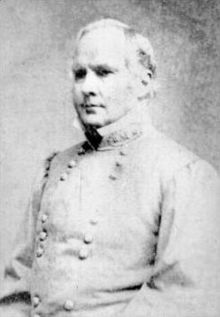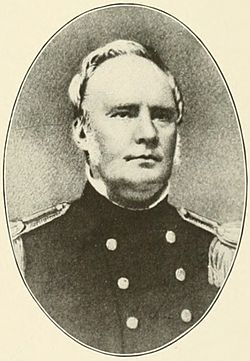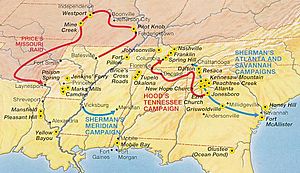Sterling Price facts for kids
Quick facts for kids
Sterling Price
|
|
|---|---|
 |
|
| Nickname(s) | "Old Pap" |
| Born | September 20, 1809 Prince Edward County, Virginia |
| Died | September 29, 1867 (aged 58) St. Louis, Missouri |
| Place of burial |
Bellefontaine Cemetery
St. Louis, Missouri |
| Allegiance | |
| Service/ |
|
| Years of service | 1831–1846, 1848–1861 (Missouri State Guard) 1846–1848 (USA) 1861–1865 (CSA) |
| Rank | |
| Battles/wars | Missouri Mormon War Mexican-American War American Civil War |
Sterling Price (born September 20, 1809 – died September 29, 1867) was an important person from Missouri, USA. He was a soldier, a lawyer, and a politician. Price served as a brigadier general in the United States Army during the Mexican–American War. Later, he became the governor of Missouri from 1853 to 1857.
During the American Civil War, Price was a Major general for the Confederate States Army. He is known for his wins in New Mexico and Chihuahua during the Mexican War. However, he faced defeats at the Battles of Pea Ridge and Westport in the Civil War. After the war, Price went to Mexico with his remaining troops instead of surrendering. He tried to join Emperor Maximilian's army but was not successful. He later returned to Missouri and died in St. Louis.
Contents
Early Life and Political Start
Sterling Price was born in Prince Edward County, Virginia. His family came from Wales. He studied law at Hampden-Sydney College in 1826 and 1827. After his studies, he became a lawyer.
In 1831, Price and his family moved to Fayette, Missouri. A year later, they moved to Keytesville, Missouri. There, he managed a hotel and a store. On May 14, 1833, he married Martha Head. They had seven children, and five lived to be adults.
In 1838, Price helped look into problems between Latter Day Saints and other groups in western Missouri. He reported that the Mormons were not guilty of the charges against them. After the Mormons surrendered, Governor Lilburn Boggs sent Price and his soldiers to protect them. Price was elected to the Missouri House of Representatives several times between 1836 and 1844. He also served as its speaker. In 1845, he was elected to the United States House of Representatives. He left this job in 1846 to fight in the Mexican–American War.
Serving in the Mexican-American War
Price formed a group of volunteer cavalry soldiers. He was made a Colonel on August 12, 1846. He led his soldiers to Santa Fe. There, he took command of the New Mexico Territory after General Stephen W. Kearny left. Price became the military governor of New Mexico. He stopped an uprising by Native Americans and Mexicans in January 1847, known as the Taos Revolt.
President James K. Polk promoted Price to brigadier general in July 1847. He also became the military governor of Chihuahua. On March 16, 1848, he led 300 men at the Battle of Santa Cruz de Rosales. They defeated a Mexican force three times their size. This was the last battle of the war. It happened days after the Treaty of Guadalupe Hidalgo was approved by the U.S. Congress. Price was honorably discharged in November 1848. He returned to Missouri as a hero.
Governor of Missouri
After the war, Price became a slave owner and grew tobacco. Because he was popular from his war service, he was easily elected Governor of Missouri in 1852. He served from 1853 to 1857.
During his time as governor, Washington University in St. Louis was started. The state's public school system was improved. The Missouri State Teachers Association was created. The state's railroad system grew, and a state geological survey was set up. Price also helped get a rail line built through his home county. This line is now part of the Norfolk and Western Railway.
Civil War Service
Early Months of the War
When the Civil War began, Price did not want Missouri to leave the Union. He was chosen to lead the Missouri State Convention in February 1861. This group voted against Missouri leaving the Union. However, things changed when Francis Preston Blair, Jr. and Captain Nathaniel Lyon took control of the state's militia at Camp Jackson in St. Louis.
Price was very upset by this. He then sided with those who wanted to leave the Union. The pro-Confederate Governor Claiborne Fox Jackson put Price in charge of the new Missouri State Guard in May 1861. He led his young soldiers, who called him "Old Pap," to try and keep Missouri for the Confederacy.
A famous battle was the Battle of Wilson's Creek on August 10, 1861. Price's Missouri State Guard and Confederate troops defeated Union forces. General Lyon was killed in this battle. After this win, Price's troops moved into Northern Missouri. They defeated Federal forces at the First Battle of Lexington. But more Union troops forced Price and Jackson's men to retreat. This left most of the state under Union control.
Battles at Pea Ridge, Iuka, and Corinth
Price was still a Missouri militia general. He could not agree with General Benjamin McCulloch on what to do after Wilson's Creek. This caused the Confederate forces in the West to split. Later, Earl Van Dorn became the overall commander. He brought Price's and McCullough's groups together into the Army of the West.
Price was made a major general in the Confederate States Army on March 6, 1862. Van Dorn's army attacked Union forces at Pea Ridge on March 7–8. Price was wounded but pushed back the Union forces on March 7. However, the battle was lost the next day after a strong Union counterattack.
Price then moved his troops across the Mississippi River. He went to help General P. G. T. Beauregard's army at Corinth, Mississippi. Price captured the Union supply base at Iuka. But he was pushed back by General William Rosecrans at the Battle of Iuka on September 19, 1862. A few weeks later, on October 3–4, Price and Van Dorn were defeated at the Second Battle of Corinth.
Price was unhappy with Van Dorn and wanted to go back to Missouri. He went to Richmond, the Confederate capital. He met with Confederate President Jefferson Davis. Davis questioned Price's loyalty to the South. Price managed to get permission to return to Missouri.
Campaigns in Arkansas and Louisiana
Price continued to command Confederate forces. In the summer of 1863, he fought for control of Arkansas. He won some battles but could not remove Union forces from the state.
In early 1864, Confederate General Edmund Kirby Smith ordered Price to send his infantry to Shreveport. Price arrived in Shreveport on March 24 with 5,000 men. However, Kirby-Smith kept the soldiers there and split them into smaller groups. He was worried about fighting Union General Nathaniel P. Banks.
Price's Missouri Raid
Despite his past problems, Price convinced his leaders to let him invade Missouri in the fall of 1864. He hoped to win the state for the Confederacy. General Kirby Smith agreed but had to send some of Price's infantry elsewhere. This changed Price's plan from a full invasion to a large cavalry raid. Price gathered 12,000 horsemen and fourteen cannons.
The first major fight in Price's Raid was at Pilot Knob. He captured Fort Davidson but lost many men for little gain. From Pilot Knob, he moved west, away from St. Louis (his main goal). He headed toward Kansas City, Missouri and Fort Leavenworth, Kansas. He had to go around Jefferson City, Missouri, which was well-protected. Price caused a lot of damage across Missouri. His army got smaller due to losses, disease, and soldiers leaving.
Price defeated smaller Federal forces at Glasgow, Lexington, the Little Blue River, and Independence. But Price was trapped by two Northern armies at Battle of Westport, in today's Kansas City. He had to fight a much larger army. This battle, called "The Gettysburg of the West," did not go well for him. He was forced to retreat into Kansas. More defeats followed. Price's tired army was pushed south into Arkansas, and then further south into Texas. Price stayed there until the war ended. Price's Raid was his last big military action. It was also the last major Confederate campaign west of the Mississippi River.
After the War and Death
Instead of surrendering when the war ended, Price led his remaining army into Mexico. He wanted his soldiers to serve Emperor Maximilian, but Maximilian refused. Price became a leader of a group of Confederates who moved to Carlota, Veracruz. But the colony failed, so he returned to Missouri.
While in Mexico, Price started having severe stomach problems. These got worse in August 1866 when he got typhoid fever. Price was poor and in bad health. He died of cholera in St. Louis, Missouri. His death certificate said he died from "chronic diarrhea." Price's funeral was on October 3, 1867, in St. Louis. His funeral procession was the largest in St. Louis up to that time. He was buried in Bellefontaine Cemetery.
Images for kids
See also
 In Spanish: Sterling Price para niños
In Spanish: Sterling Price para niños




